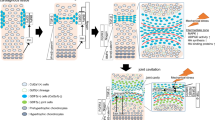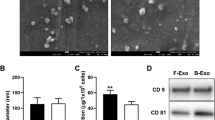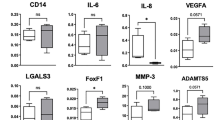Abstract
Osteoarthritis (OA) is the most common form of chronic musculoskeletal disorders. A migratory stem cell population termed chondrogenic progenitor cells (CPC) with in vitro chondrogenic potential was previously isolated from OA cartilage. Since intracellular Ca2+ signalling is an important regulator of chondrogenesis, we aimed to provide a detailed understanding of the Ca2+ homeostasis of CPCs. In this work, CPCs immortalised by lentiviral administration of the human telomerase reverse transcriptase (hTERT) and grown in monolayer cultures were studied. Expressions of all three IP3Rs were confirmed, but no RyR subtypes were detected. Ca2+ oscillations observed in CPCs were predominantly dependent on Ca2+ release and store replenishment via store-operated Ca2+ entry; CPCs express both STIM1 and Orai1 proteins. Expressions of adenosine receptor mRNAs were verified, and adenosine elicited Ca2+ transients. Various P2 receptor subtypes were identified; P2Y1 can bind ADP; P2Y4 is targeted by UTP; and ATP may evoke Ca2+ transients via detected P2X subtypes, as well as P2Y1 and P2Y2. Enzymatic breakdown of extracellular nucleotides by apyrase completely abrogated Ca2+ oscillations, suggesting that an autocrine/paracrine purinergic mechanism may drive Ca2+ oscillations in these cells. As CPCs possess a broad spectrum of functional molecular elements of Ca2+ signalling, Ca2+-dependent regulatory mechanisms can be supposed to influence their differentiation potential.





Similar content being viewed by others
Abbreviations
- 2-APB:
-
2-Aminoethoxydiphenyl borate
- ARC:
-
Arachidonic acid-regulated Ca2+ channel
- CPA:
-
Cyclopiazonic acid
- CPC:
-
Chondrogenic progenitor cell
- CRAC:
-
Calcium release activated Ca2+ channel
- ESC:
-
Embryonic stem cell
- FTHM:
-
Full time at half maximum
- HDC:
-
High density cell culture
- hTERT:
-
Human telomerase reverse transcriptase
- IP3R:
-
Inositol 1,2,3-trisphosphate receptor
- MSC:
-
Mesenchymal stem cell
- NCX:
-
Sodium calcium exchanger
- OA:
-
Osteoarthritis
- PBST:
-
Phosphate-buffered saline with Tween 20
- PG:
-
Proteoglycan
- PMCA:
-
Plasma membrane Ca2+-ATPase
- RyR:
-
Ryanodine receptor
- SDS–PAGE:
-
Sodium dodecyl sulphate polyacrylamide gel electrophoresis
- SERCA:
-
Sarcoplasmic/endoplasmic reticulum Ca2+-ATPase
- SOCE:
-
Store-operated Ca2+ entry
- STIM:
-
Stromal interacting molecule
References
Bird GS, Hwang SY, Smyth JT, Fukushima M, Boyles RR, Putney JW Jr (2009) STIM1 is a calcium sensor specialized for digital signaling. Curr Biol 19(20):1724–1729. doi:10.1016/j.cub.2009.08.022
Bootman MD, Collins TJ, Mackenzie L, Roderick HL, Berridge MJ, Peppiatt CM (2002) 2-aminoethoxydiphenyl borate (2-APB) is a reliable blocker of store-operated Ca2+ entry but an inconsistent inhibitor of InsP3-induced Ca2+ release. FASEB J 16(10):1145–1150. doi:10.1096/fj.02-0037rev
Burnstock G (2007) Purine and pyrimidine receptors. Cell Mol Life Sci 64(12):1471–1483. doi:10.1007/s00018-007-6497-0
Bygrave FL, Benedetti A (1996) What is the concentration of calcium ions in the endoplasmic reticulum? Cell Calcium 19(6):547–551
Carroll SH, Ravid K (2013) Differentiation of mesenchymal stem cells to osteoblasts and chondrocytes: a focus on adenosine receptors. Expert Rev Mol Med 15:e1. doi:10.1017/erm.2013.2
Ciciarello M, Zini R, Rossi L, Salvestrini V, Ferrari D, Manfredini R, Lemoli RM (2013) Extracellular purines promote the differentiation of human bone marrow-derived mesenchymal stem cells to the osteogenic and adipogenic lineages. Stem Cells Dev 22(7):1097–1111. doi:10.1089/scd.2012.0432
D’Alimonte I, Nargi E, Lannutti A, Marchisio M, Pierdomenico L, Costanzo G, Iorio PD, Ballerini P, Giuliani P, Caciagli F, Ciccarelli R (2013) Adenosine A1 receptor stimulation enhances osteogenic differentiation of human dental pulp-derived mesenchymal stem cells via WNT signaling. Stem Cell Res 11(1):611–624. doi:10.1016/j.scr.2013.04.002
Dolmetsch RE, Lewis RS, Goodnow CC, Healy JI (1997) Differential activation of transcription factors induced by Ca2+ response amplitude and duration. Nature 386(6627):855–858. doi:10.1038/386855a0
Ferrero ME (2009) A new approach to the inflammatory/autoimmune diseases. Recent Pat Antiinfect Drug Discov 4(2):108–113
Fodor J, Matta C, Juhasz T, Olah T, Gonczi M, Szijgyarto Z, Gergely P, Csernoch L, Zakany R (2009) Ionotropic purinergic receptor P2X4 is involved in the regulation of chondrogenesis in chicken micromass cell cultures. Cell Calcium 45(5):421–430. doi:10.1016/j.ceca.2009.02.004
Fodor J, Matta C, Olah T, Juhasz T, Takacs R, Toth A, Dienes B, Csernoch L, Zakany R (2013) Store-operated calcium entry and calcium influx via voltage-operated calcium channels regulate intracellular calcium oscillations in chondrogenic cells. Cell Calcium 54(1):1–16. doi:10.1016/j.ceca.2013.03.003
Gharibi B, Abraham AA, Ham J, Evans BA (2011) Adenosine receptor subtype expression and activation influence the differentiation of mesenchymal stem cells to osteoblasts and adipocytes. J Bone Miner Res 26(9):2112–2124. doi:10.1002/jbmr.424
Grierson JP, Meldolesi J (1995) Shear stress-induced [Ca2+]i transients and oscillations in mouse fibroblasts are mediated by endogenously released ATP. J Biol Chem 270(9):4451–4456
Grynkiewicz G, Poenie M, Tsien RY (1985) A new generation of Ca2+ indicators with greatly improved fluorescence properties. J Biol Chem 260(6):3440–3450
Harper MT, Poole AW (2011) Store-operated calcium entry and non-capacitative calcium entry have distinct roles in thrombin-induced calcium signalling in human platelets. Cell Calcium 50(4):351–358. doi:10.1016/j.ceca.2011.06.005
Hoth M, Niemeyer BA (2013) The neglected CRAC proteins: Orai2, Orai3, and STIM2. Curr Top Membr 71:237–271. doi:10.1016/B978-0-12-407870-3.00010-X
Hu J, Qin K, Zhang Y, Gong J, Li N, Lv D, Xiang R, Tan X (2011) Downregulation of transcription factor Oct4 induces an epithelial-to-mesenchymal transition via enhancement of Ca2+ influx in breast cancer cells. Biochem Biophys Res Commun 411(4):786–791. doi:10.1016/j.bbrc.2011.07.025
Jacobson KA, Ivanov AA, de Castro S, Harden TK, Ko H (2009) Development of selective agonists and antagonists of P2Y receptors. Purinergic Signal 5(1):75–89. doi:10.1007/s11302-008-9106-2
Kapur N, Mignery GA, Banach K (2007) Cell cycle-dependent calcium oscillations in mouse embryonic stem cells. Am J Physiol Cell Physiol 292(4):C1510–C1518. doi:10.1152/ajpcell.00181.2006
Karlsson C, Dehne T, Lindahl A, Brittberg M, Pruss A, Sittinger M, Ringe J (2010) Genome-wide expression profiling reveals new candidate genes associated with osteoarthritis. Osteoarthritis Cartilage 18(4):581–592. doi:10.1016/j.joca.2009.12.002
Katebi M, Soleimani M, Cronstein BN (2009) Adenosine A2A receptors play an active role in mouse bone marrow-derived mesenchymal stem cell development. J Leukoc Biol 85(3):438–444. doi:10.1189/jlb.0908520
Kawano S, Otsu K, Kuruma A, Shoji S, Yanagida E, Muto Y, Yoshikawa F, Hirayama Y, Mikoshiba K, Furuichi T (2006) ATP autocrine/paracrine signaling induces calcium oscillations and NFAT activation in human mesenchymal stem cells. Cell Calcium 39(4):313–324. doi:10.1016/j.ceca.2005.11.008
Kawano S, Otsu K, Shoji S, Yamagata K, Hiraoka M (2003) Ca(2+) oscillations regulated by Na(+)-Ca(2+) exchanger and plasma membrane Ca(2+) pump induce fluctuations of membrane currents and potentials in human mesenchymal stem cells. Cell Calcium 34(2):145–156
Kawano S, Shoji S, Ichinose S, Yamagata K, Tagami M, Hiraoka M (2002) Characterization of Ca(2+) signaling pathways in human mesenchymal stem cells. Cell Calcium 32(4):165–174
Koelling S, Kruegel J, Irmer M, Path JR, Sadowski B, Miro X, Miosge N (2009) Migratory chondrogenic progenitor cells from repair tissue during the later stages of human osteoarthritis. Cell Stem Cell 4(4):324–335. doi:10.1016/j.stem.2009.01.015
Kupzig S, Walker SA, Cullen PJ (2005) The frequencies of calcium oscillations are optimized for efficient calcium-mediated activation of Ras and the ERK/MAPK cascade. Proc Natl Acad Sci U S A 102(21):7577–7582. doi:10.1073/pnas.0409611102
Kurebayashi N, Ogawa Y (2001) Depletion of Ca2+ in the sarcoplasmic reticulum stimulates Ca2+ entry into mouse skeletal muscle fibres. J Physiol 533(1):185–199
Kwon HJ (2012) Extracellular ATP signaling via P2X(4) receptor and cAMP/PKA signaling mediate ATP oscillations essential for prechondrogenic condensation. J Endocrinol 214(3):337–348. doi:10.1530/JOE-12-0131
Loredo GA, Benton HP (1998) ATP and UTP activate calcium-mobilizing P2U-like receptors and act synergistically with interleukin-1 to stimulate prostaglandin E2 release from human rheumatoid synovial cells. Arthritis Rheum 41(2):246–255. doi:10.1002/1529-0131(199802)41:2<246::AID-ART8>3.0.CO;2-I
Lorenzo P, Bayliss MT, Heinegard D (2004) Altered patterns and synthesis of extracellular matrix macromolecules in early osteoarthritis. Matrix Biol 23(6):381–391. doi:10.1016/j.matbio.2004.07.007
Mankin HJ, Lippiello L (1970) Biochemical and metabolic abnormalities in articular cartilage from osteo-arthritic human hips. J Bone Joint Surg Am 52(3):424–434
Martel-Pelletier J, Boileau C, Pelletier JP, Roughley PJ (2008) Cartilage in normal and osteoarthritis conditions. Best Pract Res Clin Rheumatol 22(2):351–384. doi:10.1016/j.berh.2008.02.001
Matta C, Fodor J, Szijgyarto Z, Juhasz T, Gergely P, Csernoch L, Zakany R (2008) Cytosolic free Ca2+ concentration exhibits a characteristic temporal pattern during in vitro cartilage differentiation: a possible regulatory role of calcineurin in Ca-signalling of chondrogenic cells. Cell Calcium 44(3):310–323. doi:10.1016/j.ceca.2007.12.010
Matta C, Mobasheri A (2014) Regulation of chondrogenesis by protein kinase C: emerging new roles in calcium signalling. Cell Signal. doi:10.1016/j.cellsig.2014.01.011
Matta C, Zakany R (2013) Calcium signalling in chondrogenesis: implications for cartilage repair. Front Biosci 5:305–324, Schol Ed
Mignen O, Thompson JL, Shuttleworth TJ (2009) The molecular architecture of the arachidonate-regulated Ca2 + -selective ARC channel is a pentameric assembly of Orai1 and Orai3 subunits. J Physiol 587(17):4181–4197. doi:10.1113/jphysiol.2009.174193
Miyakawa T, Maeda A, Yamazawa T, Hirose K, Kurosaki T, Iino M (1999) Encoding of Ca2+ signals by differential expression of IP3 receptor subtypes. EMBO J 18(5):1303–1308. doi:10.1093/emboj/18.5.1303
Mobasheri A, Henrotin Y (2010) Identification, validation and qualification of biomarkers for osteoarthritis in humans and companion animals: mission for the next decade. Vet J 185(2):95–97. doi:10.1016/j.tvjl.2010.05.026
Muramatsu S, Wakabayashi M, Ohno T, Amano K, Ooishi R, Sugahara T, Shiojiri S, Tashiro K, Suzuki Y, Nishimura R, Kuhara S, Sugano S, Yoneda T, Matsuda A (2007) Functional gene screening system identified TRPV4 as a regulator of chondrogenic differentiation. J Biol Chem 282(44):32158–32167. doi:10.1074/jbc.M706158200
Nguyen C, Lieberherr M, Bordat C, Velard F, Come D, Liote F, Ea HK (2012) Intracellular calcium oscillations in articular chondrocytes induced by basic calcium phosphate crystals lead to cartilage degradation. Osteoarthritis Cartilage 20(11):1399–1408. doi:10.1016/j.joca.2012.07.017
Picher M, Graff RD, Lee GM (2003) Extracellular nucleotide metabolism and signaling in the pathophysiology of articular cartilage. Arthritis Rheum 48(10):2722–2736. doi:10.1002/art.11289
Piirainen H, Ashok Y, Nanekar RT, Jaakola VP (2011) Structural features of adenosine receptors: from crystal to function. Biochim Biophys Acta 1808(5):1233–1244. doi:10.1016/j.bbamem.2010.05.021
Ralevic V, Burnstock G (1998) Receptors for purines and pyrimidines. Pharmacol Rev 50(3):413–492
Ramage L, Martel MA, Hardingham GE, Salter DM (2008) NMDA receptor expression and activity in osteoarthritic human articular chondrocytes. Osteoarthritis Cartilage 16(12):1576–1584. doi:10.1016/j.joca.2008.04.023
Rosenthal AK, Hempel D, Kurup IV, Masuda I, Ryan LM (2011) Purine receptors modulate chondrocyte extracellular inorganic pyrophosphate production. Osteoarthritis Cartilage 18(11):1496–1501. doi:10.1016/j.joca.2010.08.004
Ryzhov S, Goldstein AE, Novitskiy SV, Blackburn MR, Biaggioni I, Feoktistov I (2012) Role of A2B adenosine receptors in regulation of paracrine functions of stem cell antigen 1-positive cardiac stromal cells. J Pharmacol Exp Ther 341(3):764–774. doi:10.1124/jpet.111.190835
Sauer H, Hofmann C, Wartenberg M, Wobus AM, Hescheler J (1998) Spontaneous calcium oscillations in embryonic stem cell-derived primitive endodermal cells. Exp Cell Res 238(1):13–22. doi:10.1006/excr.1997.3809
Shih YR, Hwang Y, Phadke A, Kang H, Hwang NS, Caro EJ, Nguyen S, Siu M, Theodorakis EA, Gianneschi NC, Vecchio KS, Chien S, Lee OK, Varghese S (2014) Calcium phosphate-bearing matrices induce osteogenic differentiation of stem cells through adenosine signaling. Proc Natl Acad Sci U S A 111(3):990–995. doi:10.1073/pnas.1321717111
Stout CE, Costantin JL, Naus CC, Charles AC (2002) Intercellular calcium signaling in astrocytes via ATP release through connexin hemichannels. J Biol Chem 277(12):10482–10488. doi:10.1074/jbc.M109902200
Tao R, Sun HY, Lau CP, Tse HF, Lee HC, Li GR (2011) Cyclic ADP ribose is a novel regulator of intracellular Ca2+ oscillations in human bone marrow mesenchymal stem cells. J Cell Mol Med 15(12):2684–2696. doi:10.1111/j.1582-4934.2011.01263.x
Tian M, Duan Y, Duan X (2010) Chloride channels regulate chondrogenesis in chicken mandibular mesenchymal cells. Arch Oral Biol 55(12):938–945. doi:10.1016/j.archoralbio.2010.08.005
Varani K, De Mattei M, Vincenzi F, Tosi A, Targa M, Masieri FF, Pellati A, Massari L, Borea PA (2010) P2X(1) and P2X(3) purinergic receptors differentially modulate the inflammatory response in human osteoarthritic synovial fibroblasts. Cell Physiol Biochem 25(2-3):325–336. doi:10.1159/000276565
Varga Z, Juhasz T, Matta C, Fodor J, Katona E, Bartok A, Olah T, Sebe A, Csernoch L, Panyi G, Zakany R (2011) Switch of voltage-gated K + channel expression in the plasma membrane of chondrogenic cells affects cytosolic Ca2 + -oscillations and cartilage formation. PLoS One 6(11):e27957. doi:10.1371/journal.pone.0027957
Zhang S, Fritz N, Ibarra C, Uhlen P (2011) Inositol 1,4,5-trisphosphate receptor subtype-specific regulation of calcium oscillations. Neurochem Res 36(7):1175–1185. doi:10.1007/s11064-011-0457-7
Zippel N, Limbach CA, Ratajski N, Urban C, Luparello C, Pansky A, Kassack MU, Tobiasch E (2012) Purinergic receptors influence the differentiation of human mesenchymal stem cells. Stem Cells Dev 21(6):884–900. doi:10.1089/scd.2010.0576
Acknowledgments
We are grateful to Mrs. Krisztina Bíró and Mrs. Róza Őri for the excellent and skillful technical assistance. This work was supported by grants from the Hungarian Science Research Fund (OTKA CNK80709, OTKA NN-107765), from TÁMOP-4.2.2.A-11/1/KONV-2012-0036 and TÁMOP-4.2.2/B-10/1-2010-0024 projects, co-financed by the European Union and the European Social Fund. N.M. was supported by the German Research Foundation (Mi 573/10-1). C.M. was supported by a Mecenatura grant (DEOEC Mec-9/2011) from the Medical and Health Science Centre, University of Debrecen, Hungary; a Short-Term Fellowship from the Federation of European Biochemical Societies (FEBS); and also from the European Union through a Marie Curie Intra-European Fellowship for career development (project number: 625746; acronym: CHONDRION; FP7-PEOPLE-2013-IEF). This paper was supported by the János Bólyai Research Scholarship of the Hungarian Academy of Sciences. T.J. is supported by a Magyary Zoltán postdoctoral fellowship through the project entitled “National Excellence Program—Elaboration and implementation of a national student and researcher supporting system for the convergence region” (TÁMOP 4.2.4.A/2-11-1-2012-0001), co-financed by the Hungarian State, the European Union, and the European Social Fund.
Conflict of interest
All authors disclose that there are neither any financial nor any personal relationships with other people or organisations that could inappropriately influence (bias) their work. There are no conflicts of interests.
Author information
Authors and Affiliations
Corresponding author
Additional information
Csaba Matta and János Fodor contributed equally to the work.
Electronic supplementary material
Below is the link to the electronic supplementary material.
ESM 1
(PDF 809 kb)
Rights and permissions
About this article
Cite this article
Matta, C., Fodor, J., Miosge, N. et al. Purinergic signalling is required for calcium oscillations in migratory chondrogenic progenitor cells. Pflugers Arch - Eur J Physiol 467, 429–442 (2015). https://doi.org/10.1007/s00424-014-1529-8
Received:
Revised:
Accepted:
Published:
Issue Date:
DOI: https://doi.org/10.1007/s00424-014-1529-8




